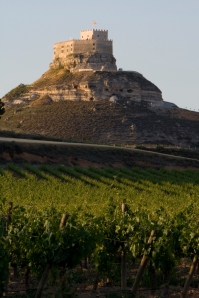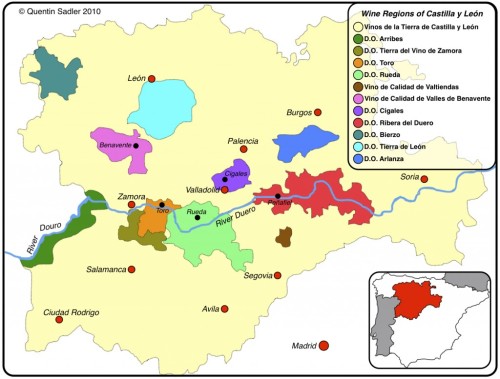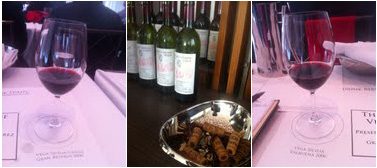Ya know, Spanish wine is a weird thing. Spain, as a nation, has more acreage devoted to wine production than any other country at 2.9 million acres. For some perspective, California only has a little more than 500,000 acres devoted to wine production and France, the world’s largest producer, squeezes its vast quantity of wine out of just under 2 million acres. And yet, while Spain has more land devoted to winemaking than anyone else, it is only the 3rd largest producer after France and Italy (first and second respectively).
I would also argue that we Americans tend to know less about Spanish wine than we do about other wines from abroad. Or at least that’s how I feel. Want me to tell you what grapes are grown in the Loire Valley versus the Cotes du Rhone? No problem… the answer rolls off my tongue, greased with confidence. Want me to tell you the difference between the wines of Piedmont and those grown in Alto Adige? Psh, please – what do I look like to you? Some sort of amateur?
Alright, tough guy – what are the differences between the grapes used in Ribera del Duero and Rioja? Ermm…umm….uh…I…. what? You know what the scariest part of that question is? It’s a trick question – the grapes are the same. Both regions use Tempranillo! I hear ya, you’re like, wait – what? Isn’t that what makes European wine so confusing? Because every region of every country uses different weird grapes that I don’t know how to pronounce properly?
That’s kind of the beauty of Spanish wine– in many ways it’s actually significantly less complicated than French or Italian wine. For example, while Spain does have its fair share of weird indigenous grapes and there are certain regions that use specific grapes rarely used anywhere else (like Mencia, only used in Galicia), there’s also a lot of continuity across wine regions in Spain that can offer a brilliant lesson in the effects of climate, geology, and geography on winemaking.
When it comes to Spanish red wine, bets are that whatever you’re drinking is comprised of Tempranillo, Garnacha, or a blend of the two. That’s a pretty wild generalization, but it’s also a good place to start. I owe it to Spain to do a full examination of all her wondrous wine regions, and to do it in the same fashion and with the same attention I’ve given to her sisters, France and Italy. But I’m not going to do it today. Because today, what I really want to talk about is Ribera del Duero.
A couple months ago, I was invited to a tasting of the wines of Ribera del Duero and I had absolutely no idea what to expect. I had no clue what these wines were all about, but being the giant nerd that I am, I did my homework and a little research. I learned that Ribera del Duero was a wine-producing region located in the Castilla y Leon region. I also realized that the closest thing I’d tasted to a wine from Ribera del Duero were the wines of Toro – pretty much Ribera’s next-door neighbor. I also realized, quickly, that both Ribera del Duero and Toro produce wines from Tempranillo (though, in Toro they like to call it Tinta de Toro).

And then I was like, oh, hey! Tempranillo! I know that grape – that’s the stuff that’s in Rioja! Sweet, I got this. So Iwalked into the tasting expecting to experience the ball-busting powerhouse wines I associated with Toro and the flavors of chocolate, oak, and dark fruit that I associated with Rioja.
Boy, oh, boy was I wrong. Dead wrong. Like, leather pants in August wrong. I hardly even know where to start, so I guess I’ll start with the Vega Sicilia, one of the most highly-regarded and revered wineries in the world. It seemed a little unfair that my introduction to the wines of Ribera del Duero would be through the region’s and, indeed probably the country of Spain’s, most prized wine. I felt poised for disappointment because how on earth could this possibly be a fair entry to the wines of the region? It would have been like sipping a LaTour or Mouton Rothschild by way of introduction to Bordeaux. It’s just simply not done.
But I did it. And I was dumbfounded. As I sat and swirled my glass of this ridiculously expensive wine, expecting the heady masculine scent I associated with Rioja and Toro, I was absolutely disoriented by the scents of eucalyptus and roses that wafted up instead. What the hell was going on here? I sipped. The wine was smooth as velvet with soft firm tannins, an ethereal light body and an acidity that kept the whole thing aloft until it had slid, like silk, down my throat. That was the Vega Sicilia Valbuena 2006 – the least prestigious of Vega Sicilia’s wines, being the one they produced every year. We still had the Vega Sicilia Unico Grand Reserva 2000 to go – a rare wine made only in the best vintages and in extremely limited amounts. This time the nose was all baked cherries with floral notes and some liquorice hovering around the edge along with a whiff of leather. This one had a little more weight to it, anchored by dusty tannins but still held aloft by an astringent herbal quality that kept it unbearably fresh. It wasn’t until you swallowed this velvety conconction that a faint streak of chocolate and earth rushed into your mouth. It was incredible. And so light.
I floated out of the seminar and into the elevator to be whisked down into the main tasting room. Surely, I thought, this was all some sort of gross misunderstanding. I must have missed something – these wines were so elegant, so fresh, so pretty! They were nothing like the rich, kick-you-around wines I was expecting from Toro or the warm, comforting give-you-a-hug wines of Rioja…there was more to this than I thought. And so I marched on.
The wines of Ribera del Duero have another thing in common with the wines of Rioja (besides the use of Tempranillo) in that they employ the same classification system whereby they are categorized according to the amount of time they’ve spent in oak:
• Cosecha or Joven: These wines usually do not see any oak. “Joven Roble” and “Joven Barrica” are aged for only three to six months in oak and released soon after harvest. As a result, they are fruity, vibrant, and meant to be consumed young.
• Crianza: Aged two years with a minimum of one year in oak barrels. These wines usually have well-balanced tannins with a medium-to-full body.
• Reserva: Aged three years, with a minimum one one year in oak barrels. After at least one year in oak barrels, Reserva wines are bottle-aged in winery cellars, producing wines that are ready to drink once they are released – they are more intense, richer, and have a longer finish.
• Gran Riserva: Gran Riservas are wines that are only produced in the very best vintages. They are aged fro a minimum of five years, with a minimum of two years in oak barrels, followed by additional bottle aging. These are complex, structured, balanced, and the biggest examples of Ribera wines.
The most amazing aspect of these wines though, especially for any drinker familiar with the wines of Rioja, is how absolutely and terrifically different they are. Even though these wines are made from the same grape in much the same manner, they couldn’t be more different.
The take away I had from this whole experience was that the wines of Ribera del Duero are incredibly fresh and elegant. Scattered among my tasting notes are phrases like “really light”, “lovely and floral”, “raspberries and violets”, “baked blueberries and cinnamon!” “so fresh”, and “herbal, stony, and juicy”.
One of the reasons that the wines of Ribera del Duero manifest the Tempranillo grape so differently is the region’s geography. Most of the vineyards of Ribera are planted between 2,500 and 2,800 feet above sea level with some vineyards planted even higher. The region’s elevation contributes to wildly fluxuating daytime/nighttime temperatures during the growing season that facilitate healthy ripening of the grapes by day and promote balanced acidity and aromatic complexity at night. The region is also fairly dry, contributing to consistent ripening and soil conditions that are near-perfect with limestone and chalk that help to give the wines structure. But mostly, it’s the region’s elevation that contributes to the unbelievably fresh character of these wines.
That said, while I can surely appreciate a wine that’s gonna kick me around a little bit (see: my love affair with Priorat) – I absolutely fell in love with the younger wines of Ribera del Duero because they were so pretty and bright and fresh. That’s not to say I didn’t like the Riservas and Grand Riservas I tasted – they are more complex, more elegant, and more serious grown-up wines. But, for me, the region’s real charms were on full display in the flirty and vivacious younger wines –the Jovens and the Crianzas.
This time of year is especially perfect for these young wines of the Ribera del Duero. Here in New York, Spring has unfurled her flowers and tree branches and now turned a cold shoulder on the city – turning the sky gray and the air chilly again. And for this, the wines of Ribera del Duero – floral and pretty, but also substantial, are perfect. Take a look at some of my favorites below and, oh, did I mention that they’re also wildly affordable with a median price that lands somewhere between $10-$15/bottle? Yeah. You’re welcome.
D.O.5 Hispanobodegas, S.L.U 2010 Vina Gormaz: This joven is made from very old vines that lend a complexity and concentration to the wine that is pretty unreal. Fresh raspberries on the nose lead to a wine that has a tightly wound structure that carries the aromatics from the nose through to the palate.
Hacienda Ernestina Solano Roble 2010: This joven is light, fresh and has an absolutely gorgeous nose of flowers and fresh fruit.
Pagos de Valcerracin 2008: This Crianza was so different on the nose with notes of earth, tar and even a whiff of petrol that made me think of Reisling. On the palate, however, the wine exploded into something floral with a sweet vanilla-laced flavor and sun-ripened blackberries.Blew me away!
Pasquera 2009 Tinto Pasquera: Baked strawberries on the nose and a scent of canned cranberry sauce. It’s juicy and really drinkable.
Bodegas y Vinedos Neo 2009 Sentido Cosecha: An unbelievable nose of baked blueberries and cinnamon leads to a wine that is light and spicy with amazing balance.
Bodegas Vizcarra 2008 Celia Crianza: More of that beautiful blueberries-and-violets scent on the nose that just makes your mouth water. It smells like berry pie and fresh flowers and on the palate is light and silky.
Carmelo Rodero 2005 Valtarrena: A single vineyard Reserva that was soft, spicy, sweet and incredibly fresh.
Adarezo 100% Unoaked Vina Villano: This wine was so refreshing it was like drinking juice – blueberries and raspberries jumped out of the glass, mingling with floral perfume. On the palate it had sparkling juicy acidity and tight tannins to hold it all up. Even, at the end, a faint trace of watermelon…just lovely.
Hijos de Antonio Barcelo 2007 Vina Mayor Crianza: Really light and floral with a lovely plummy character – absolutely delicious. Right next door to Vega Sicilia’s vineyards so the quality is pretty amazing.





Leave a comment